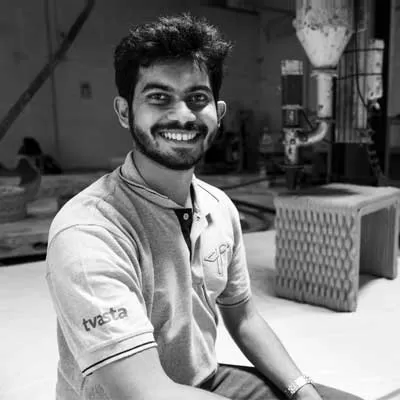Founded in 2016 by IIT-Madras alumni, Tvasta is pioneering the transformation of construction through 3D printing. By creating an end-to-end technology stack, the company focuses on faster, cost-effective and sustainable solutions, redefining industry practices and setting benchmarks for innovative, green construction methods. VS Adithya, CEO and Co-Founder, Tvasta, shares his vision, journey and long-term goals in conversation with R SRINIVASAN. Excerpts:Please share the Tvasta journey, the source of inspiration, why this name was chosen and how the funding happened. Tvasta was founded by a group of IIT-Madras alumni in 2016 with a vision to revolutionise the construction industry through 3D printing technology. We were inspired by the Make in India initiative and aimed to develop a truly indigenous solution. We’ve focused on building the entire 3D printing technology stack, right from the machines to the materials, software and processes. Our collaboration with IIT-Madras has been crucial in this endeavour.A significant achievement was the construction of India’s first 3D-printed house at IIT-Madras, which was made possible with the support of Habitat for Humanity. The project gained national recognition with the inauguration by Union Minister of Finance Nirmala Sitharaman, followed by a visit by Vice President Venkaiah Naidu. We chose the name Tvasta from Sanskrit, which signifies the process of creation. It embodies our aspiration to create innovative solutions and shape the future of construction.What is Tvasta’s core mission and what differentiates it from competitors?Tvasta’s core mission is to revolutionise the construction and manufacturing industries through 3D printing technology. We aim to build faster, more efficient and more sustainable infrastructure and building components.What sets us apart is our comprehensive approach. Unlike our competitors who often focus on a single aspect, such as machines or materials, we’ve developed the entire 3D printing technology stack. This includes our proprietary 3D printers, materials and software. By owning the entire process, we can offer end-to-end solutions, ensuring greater efficiency and control. We’re focused on automating construction processes, particularly in areas like infrastructure development and mass customisation. This will not only reduce costs but improve the quality and speed of construction.What is the company’s annual outlay on R&D?Tvasta is dedicated to significant investments in R&D. We’re focused on pushing the boundaries of materials science, robotics and automation. Our partnerships with prestigious institutions like IIT-Madras and global accelerators like Third Derivative underscore our commitment to innovation. By investing heavily in R&D, we aim to revolutionise the construction industry, delivering sustainable, cost-effective solutions.Please share details of a project as a case study of challenges faced and overcome. A pioneering endeavour, for instance, was the Kerala 3D printed summer house project, which encountered several challenges. These included technological novelty, regulatory hurdles, workforce training, material sourcing and design optimisation. To overcome these obstacles, a collaborative approach was adopted, involving industry experts and researchers. Rigorous testing and research were conducted to validate the structural integrity and durability of the concrete 3D-printed components. Skill development programs were implemented to equip the workforce with the necessary expertise. Advanced digital tools were leveraged to optimise the design and simulate the printing process. By embracing continuous innovation and staying updated with the latest advancements in 3D printing technology, the project successfully addressed these challenges. This project has set a benchmark for the future adoption of 3D printing in the construction industry, promising faster construction, reduced costs and enhanced design flexibility.What green measures have been adopted and what is the total carbon footprint reduction?We at Tvasta are committed to sustainable construction practices. 3D printing technology offers significant potential to reduce a building’s carbon footprint. By minimising material waste, optimising material usage and enabling the use of eco-friendly materials, we can significantly reduce the environmental impact of construction. Specifically, 3D printing allows for precise material deposition, reducing waste and minimising the amount of raw materials required. By streamlining the construction process and reducing labour-intensive tasks, we can significantly reduce energy consumption. Additionally, we are actively exploring and incorporating sustainable materials into our 3D printing processes, further reducing the carbon footprint of our projects.Tvasta is at the forefront of this technological revolution, working to make sustainable construction a reality. By adopting 3D printing, we aim to contribute to a greener future and create a more sustainable built environment.What technologies (AI, BIM) does your firm incorporate from planning to implementation?At Tvasta, we’re at the forefront of technological innovation in construction. We’re currently utilising BIM to streamline the design phase of our projects, enabling us to visualise and optimise designs before breaking ground. We are exploring the field of generative design for structures, optimising the complex geometries that are often difficult to achieve using traditional construction methods. The optimising technique can be used to reduce material usage while maintaining structural integrity. We are also exploring the field of integration of sensors and IoT, thus monitoring the properties of the concrete mix, ensuring the mix is adjusted in order to obtain the optimal flow, viscosity and curing time to increase the overall efficiency of the printing process.What are the company’s long-term goals?Tvasta’s long-term goal is to revolutionise the construction industry. We aim to build category-defining platform technologies that can automate 80 per cent of construction processes, making construction faster and cheaper. By developing innovative 3D printing platforms, we’re enabling the mass production of customised components. This will not only accelerate construction timelines but reduce material waste and labour costs. Ultimately, Tvasta’s technologies will reshape the construction landscape, leading to more efficient, affordable and environment-friendly building practices.




















